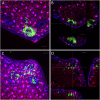Salmonella Establishment in Agricultural Soil and Colonization of Crop Plants Depend on Soil Type and Plant Species
- PMID: 31156568
- PMCID: PMC6529577
- DOI: 10.3389/fmicb.2019.00967
Salmonella Establishment in Agricultural Soil and Colonization of Crop Plants Depend on Soil Type and Plant Species
Abstract
Human pathogenic bacteria, such as Salmonella enterica, are able to colonize crop plants. So far, not much is known about biotic and abiotic factors influencing this colonization in field soil. This understanding, however, is imperative for the provision of safe fresh produce to the consumer. In this study, we investigated the effects of soil type, organic fertilization, plant species and the way of Salmonella entry into the plant production system, on the survival of S. enterica in soil as well as the colonization of plants. The selected S. enterica serovar Typhimurium strain 14028s, S. Typhimurium strain LT2 and S. Senftenberg were able to persist in soil for several weeks. Salmonella's persistence in soil was prolonged in loamy, if compared to sandy soil, and when applied together with organic fertilizer. The leaves of lettuce and corn salad were colonized by S. enterica providing evidence for internalization from the soil via the root. Colonization rates were affected by soil type, plant species and S. enterica strain. Overall, S. enterica was detected in leaves of 0.5-0.9% of the plants, while lettuce was more frequently colonized than corn salad. Plants grown in sandy soil were more often colonized than plants grown in loamy soil. After spray inoculation, S. enterica could be detected on and in leaves for several weeks by cultivation-depending methods, confirmed by confocal microscopy using GFP-labeled S. Typhimurium 14028s. On the one hand, transcriptome data from S. Typhimurium 14028s assessed in response to lettuce medium or lettuce root exudates showed an upregulation of genes associated with biofilm formation and virulence. On the other hand, lettuce inoculated with S. Typhimurium 14028s showed a strong upregulation of genes associated with plant immune response and genes related to stress response. In summary, these results showed that organic fertilizers can increase the persistence of Salmonella in soil and that soil type and plant species play a crucial role in the interactions between human pathogens and crop plants. This understanding is therefore a starting point for new strategies to provide safe food for the consumer.
Keywords: Salmonella; crop plants; internalization; persistence; plant defense; soil.
Figures










Similar articles
-
Persistence of Salmonella Typhimurium LT2 in Soil Enhanced after Growth in Lettuce Medium.Front Microbiol. 2017 Apr 28;8:757. doi: 10.3389/fmicb.2017.00757. eCollection 2017. Front Microbiol. 2017. PMID: 28503171 Free PMC article.
-
Effect of Plant Systemic Resistance Elicited by Biological and Chemical Inducers on the Colonization of the Lettuce and Basil Leaf Apoplast by Salmonella enterica.Appl Environ Microbiol. 2021 Nov 24;87(24):e0115121. doi: 10.1128/AEM.01151-21. Epub 2021 Oct 6. Appl Environ Microbiol. 2021. PMID: 34613760 Free PMC article.
-
Plant-mediated restriction of Salmonella enterica on tomato and spinach leaves colonized with Pseudomonas plant growth-promoting rhizobacteria.Int J Food Microbiol. 2017 Oct 16;259:1-6. doi: 10.1016/j.ijfoodmicro.2017.07.012. Epub 2017 Jul 27. Int J Food Microbiol. 2017. PMID: 28778009
-
Biofilm formation by enteric pathogens and its role in plant colonization and persistence.Microb Biotechnol. 2014 Nov;7(6):496-516. doi: 10.1111/1751-7915.12186. Microb Biotechnol. 2014. PMID: 25351039 Free PMC article. Review.
-
Plant Bioactive Compounds as an Intrinsic and Sustainable Tool to Enhance the Microbial Safety of Crops.Microorganisms. 2021 Nov 30;9(12):2485. doi: 10.3390/microorganisms9122485. Microorganisms. 2021. PMID: 34946087 Free PMC article. Review.
Cited by
-
Intraspecies competition among Salmonella enterica isolates in the lettuce leaf apoplast.Front Plant Sci. 2024 Jan 30;15:1302047. doi: 10.3389/fpls.2024.1302047. eCollection 2024. Front Plant Sci. 2024. PMID: 38352648 Free PMC article.
-
Factors Required for Adhesion of Salmonella enterica Serovar Typhimurium to Lactuca sativa (Lettuce).Microbiol Spectr. 2023 Feb 14;11(1):e0343622. doi: 10.1128/spectrum.03436-22. Epub 2022 Dec 19. Microbiol Spectr. 2023. PMID: 36533955 Free PMC article.
-
Broad time-dependent transcriptional activity of metabolic genes of E. coli O104:H4 strain C227/11Φcu in a soil microenvironment at low temperature.Environ Microbiol Rep. 2023 Dec;15(6):582-596. doi: 10.1111/1758-2229.13198. Epub 2023 Aug 29. Environ Microbiol Rep. 2023. PMID: 37644642 Free PMC article.
-
Role played by the environment in the emergence and spread of antimicrobial resistance (AMR) through the food chain.EFSA J. 2021 Jun 17;19(6):e06651. doi: 10.2903/j.efsa.2021.6651. eCollection 2021 Jun. EFSA J. 2021. PMID: 34178158 Free PMC article.
-
Colonization of Listeria monocytogenes in potting soils as affected by bacterial community composition, storage temperature, and natural amendment.Food Sci Biotechnol. 2021 Jun 11;30(6):869-880. doi: 10.1007/s10068-021-00925-9. eCollection 2021 Jun. Food Sci Biotechnol. 2021. PMID: 34249393 Free PMC article.
References
-
- Basak B. B., Pal S., Datta S. C. (2012). Use of modified clays for retention and supply of water and nutrients. Curr. Sci. 102 1272–1278.
LinkOut - more resources
Full Text Sources
Molecular Biology Databases

